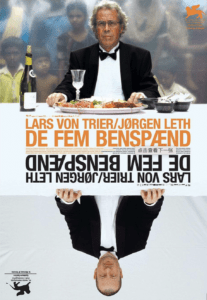- Obstruction 1: no edit more than 12 frames long; film in Cuba, somewhere he’s never been before; not allowed to build a set; find answers to the perfect human. Jorgen repeats the same scene multiple times.
Obstruction 2: being sent to a miserable place; any theme cannot be exploited; film but not show what you’re describing. Jorgen is the man; the meal will be there.
He uses drama from real-life restraints from filming. He involves stepping up and showing the distance and tells the character to just eat and finish the scene. They use a transparent screen to minimize the distance. They interpreted that loosely, putting up a screen and screening off this bit of real life. The whole idea is that we mustn’t see them
Obstruction 3: wasn’t true to the idea. make a film with no rules from me. a free-style film. completely freedom or back to Bombay. They go up to the set-up and move them around into a new interesting arrangement. He frames places and things precisely
Obstruction 4: cartoon. They use aid stuff actively, write a new text into it and breathe freshness into it
Obstruction 5:Lars Von Trier will make the last obstruction, Jorgen Leth will be credited as director, and Jorgen Leth will read a text written by Lars von Trier. Jorgen doesn’t have to do anything.
2. Effect
“It shows me what I really am, an object, human.” Jorgen makes a film that leaves a mark on you. The movie serves as therapy.
3. Thoughts
It’s interesting how the film master is trying to make crap. In fact, they’re experimenting with something really innovative. The content remains the same but they’re using the basic forms of the movie to recreate the Perfect human. They explored the technique, figures, personal limit, formula, and deprivation of contents. Jorgen keeps reflecting on himself. It’s nice to see how these filmmakers break the boundaries and make a breakthrough.